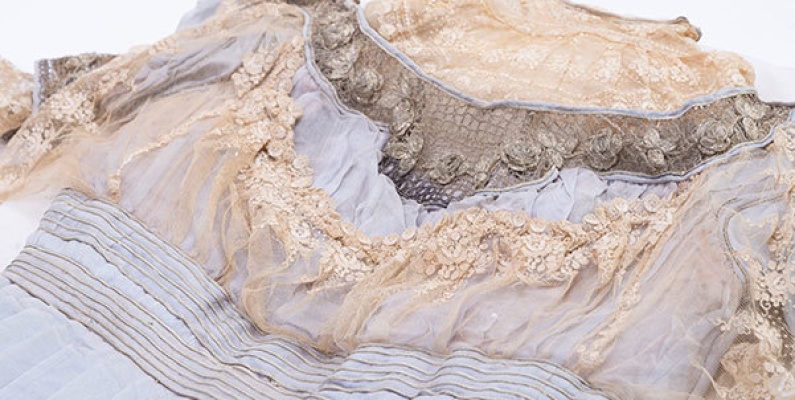
At first sight, the pale blue dress with the lacy yoke on display in the fanciest category looks a bit like an overgrown Kate Greenaway child’s dress, with tucks round the lower skirt as if the wearer still had growing to do. Indeed, a young lady in her teens wore this dress: Louise Marie Alexandrine von Eppinghoven, a granddaughter of King Leopold I of Belgium.

Image: Marigold Garden. Illustration by Kate Greenaway. Public Domain Mark.
The dress was designed and made in the couture house of Gustave Beer, a German-born, Paris-based dress designer from 1905. He’d moved to Paris after running a dressmaking business in Vienna. By 1905, Paris was the centre of fashion for wealthy elites and couture was a growth industry, supported by many suppliers of fabrics and trims. From other garments in the Eppinghoven collection in Otago Museum, we know that Louise Marie, her mother Anna, and grandmother Arcadie went to Paris often to order clothes for their wardrobes.

Image: Evening gown designed by Gustav Beer. Europe, early 20th century. Eppinghoven Collection; Otago Museum Collection. G2013.35. By Kane Fleury © Otago Museum.
Close inspection of this gorgeous dress (which we realise is a little difficult in the exhibition itself, hence the close-up photographs on the touchscreens) reveals some of Beer’s techniques to create opulence. There are multiple layers to both bodice and skirt.
Different net laces make up the neckline, sleeves and overlayers on the bodice, while a metallic lace that looks like filet but is a kind of leno weave, creates a yoke over at least two layers of the net. Silver wrapped cotton or silk thread is formed into roses and leaves that have been couched onto the leno weave. Pale blue chiffon fabric is gathered below and forms puffed oversleeves. The wide waistbands each feature six parallel rows of stitched silver braid which hold the pleats of the skirt in place. Under the skirt is a layer of net with applied sequins that would have glittered as the wearer danced or moved.
The dress is lined with silk, which is now very fragile, as is the case with many silks of this period. This is why the dress is displayed rather two-dimensionally: the lining is too delicate for it to be put onto a dress form.
est. 1868 is open daily in the Special Exhibitions Gallery, 10am to 5pm, until 14 April 2019. Entry is free.
Top image: Evening gown designed by Gustav Beer. Europe, early 20th century. Eppinghoven Collection; Otago Museum Collection. G2013.35. By Kane Fleury © Otago Museum.
